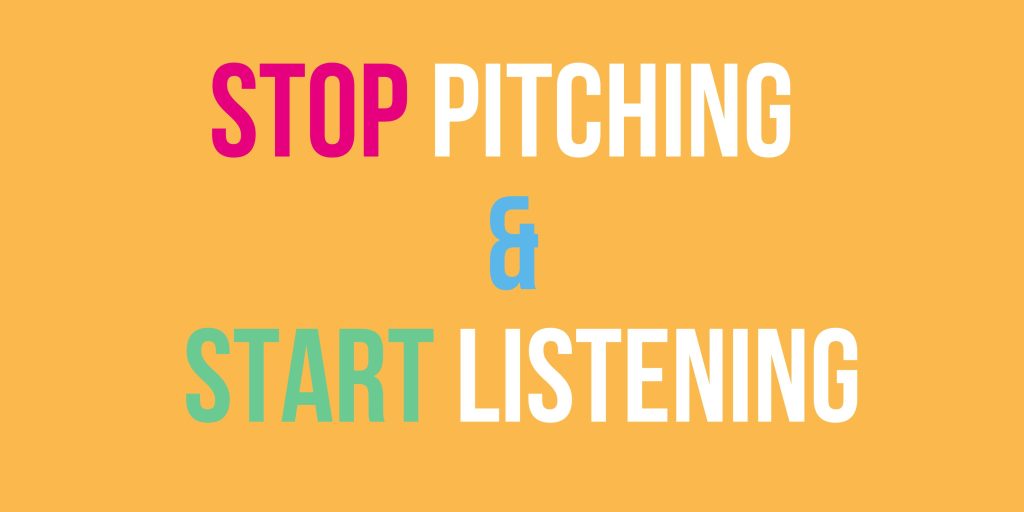Sales professionals often get the image of being a "slick salesman". Someone who talks a lot, even if it becomes a monologue, and tries to sell people all kinds of things.
Let's get rid of this stigma!
How?

10 tips to learn to listen better during a sales call
Sit or stand upright
First things first, it all starts with non-verbal communication. Adopt an interested posture. Don't cower in front of your interlocutors, but sit straight or stand up straight. Non-verbal communication reflects much more than you think. For instance, how confident you come across or how at ease you are often depends on your posture, but also how credible you are actually perceived to be.
Focus fully on the conversation
There is nothing more irritating than a conversation partner who is only half listening to what you are saying and perhaps checking his watch or worse, constantly looking at his phone. You create the feeling that the person you're sitting across from is not interesting or that you don't really care at all. Your potential clients have set aside time in their calendar to meet with you, to see how you can help them further and possibly start a collaboration. You'd better be focused on the conversation then.
Don't judge
Judging, giving your opinion (especially if it is not asked for) and assumptions are better left at home. It does not benefit communication and it interferes with the objectivity of your conversation. As they say in English "To assume makes an ass out of you and me". Base yourself on facts and observations during your conversation instead of assuming things. Communicating clearly and in detail will help you and your interlocutor. Question yourself or the other person from time to time instead of immediately making judgements or assumptions.
Do not interrupt your interlocutor
Let each other speak and do not intervene when you see that the person in front of you has not finished his/her story at all. What you can do is summarise what the person in front of you has just said. Check that you have understood it all correctly and bonus, it shows that you have listened sincerely.
Avoid distractions
We talked earlier in this blog about how terrible it is to have a conversational partner who is on their mobile phone during a conversation. Distractions can be more than engaging effectively in other things. For example, when you are thinking inside yourself what you want to say or how you are going to respond to something. You are no longer listening to what the person in front of you is saying, but you are preoccupied with yourself. We went from a dialogue to 2 monologues.
Show interest in your interlocutor
You can show interest in a conversation in different ways, both verbal and non-verbal. Think of yes nods, a smile or someone looking at you while you are talking. All confirmations that your interlocutor is paying attention. Besides yes-nodding, it can also be simply spoken. Furthermore, you also show interest by asking questions. Just make sure not to constantly interrupt your interlocutor with your questions.
Pause briefly before answering
Euhm... Euuuhm... we all have it sometimes. Ever thought of just not saying anything for a while? Inserting a pause or a moment of silence in your conversation often makes you choose your words better first of all and also allows you to think just that little bit longer about what exactly you are going to say. People often panic if they cannot answer a question immediately, for example. No stress... Take a break, think about your answer and voila.
Listen to understand, not respond
Some people hear something and immediately have to give a counter-reaction to it. These are people who listen to respond rather than listen to understand something or someone. Often this is to defend themselves or solve something and this can cause uncomfortable conversations. Listening to understand ensures that you take the time to really hear what someone is saying and feel what it is like for your interlocutor.
Give non-verbal recognition
In the first tip, we mentioned that non-verbal communication is just as important as verbal communication. It shows your interlocutor that you are listening, that you are showing interest and it shows your feelings. Is your conversation partner saying something you agree with, just nodding yes lets them know you are on the same wavelength.
Adapt your facial expressions to the conversation
Besides body posture, eye contact and gestures, your facial expression is also an important factor within non-verbal communication. Your facial expressions often reflect your feelings and add strength to the words you use. When your facial expressions match what you say, it increases your interlocutor's confidence as well as clarity and connection.




